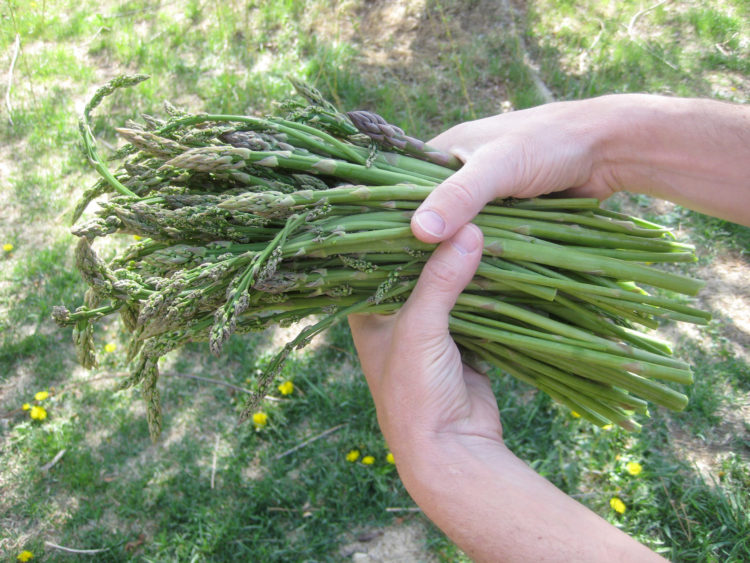 My friend Butter has been collecting wild asparagus with her family for many years. “Hunting for, and eating wild asparagus is such a long-standing and special tradition in my home, that I refuse to eat it store-bought, ever,” she writes.
My friend Butter has been collecting wild asparagus with her family for many years. “Hunting for, and eating wild asparagus is such a long-standing and special tradition in my home, that I refuse to eat it store-bought, ever,” she writes.
To me it’s funny how Butter could be out there getting down and dirty with wild asparagus (Asparagus officinalis) for all this time when in my world, wild asparagus has always been the stuff of legend.
It reads like a fairytale in Euell Gibbon’s book, Stalking the Wild Asparagus (1962), which is not only the title of his historic wild edible manifesto but also a chapter. I was a young woman when I first read his account—how, as a boy en route to fishing, the young Euell stumbled upon wild asparagus growing in clumps alongside an irrigation ditch, then spent a blissful week collecting it and bringing it home for his family, a true provider. Before another spring, however, his parents moved them to a “high, dry plateau farther west” and “I was a middle-aged man before I saw wild asparagus again.”
Oh, the tragedy of it! And, if Euell Gibbons couldn’t find wild asparagus for decades, how was I to do it? Of course what I didn’t realize was how ubiquitous wild asparagus truly is—as long as you’re looking for it in the right place, that is.
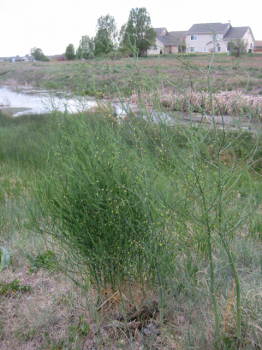
Wild asparagus does not grow deep in a virgin forest, along a creek running through said forest, or high up in the mountains. It is a lover of fields and agricultural places, fence posts and hedgerows, neighbor to the selfsame Asparagus ancestors once tended by human hand—after all, wild asparagus, Gibbons says for the U.S., “is exactly the same species as the cultivated varieties.”
First Sighting
I saw some once, a few years ago, when a friend pointed out the car window towards the tall, fern-like foliage of over-mature asparagus spears growing on a field-adjacent roadside in Ithaca, New York—but then, zoom! It was gone.
And then, about a month ago, Butter marched me bushwhacking and limping through an overgrown field down by a pond to the place where the wild asparagus grows. There weren’t any spears up at the time, but seeing the plants was an epiphany—a perspective shifter of such magnitude as to transform fiction into reality.
Then she made wild asparagus the honorary ingredient of the May Recipe Share on her Hunger and Thirst blog. “You may submit either new or archived posts, but your recipe must include foraged asparagus,” she wrote. So now I had to find my own wild asparagus before a month’s time was up, and then cook something great with it to boot.
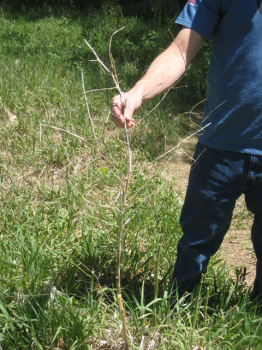
First Foraged
When we got to Gregg’s sister’s house in Fort Collins two weeks ago she bounded excitedly up to me to announce that there was asparagus growing in the unkempt space in the middle of the housing development where she walks her dogs. She’d never batted an eye at my wild obsession before, but I guess there is something about finding the exact same costly produce you like to eat on a regular basis growing at your doorstep.
Was it to be that easy, then? I wondered. All this time, no asparagus, and then Wendy has it growing out her back door… Madness, I tell you! But I also wondered whether or not someone else’s found asparagus counts. Because I still had yet to find my own.
Nevertheless, once she showed me her spot we started noticing asparagus plants scattered across the field and alongside the cattail-laden irrigation ditches that crisscross it. Mostly I spotted them by the tall, green, fern-like foliage of asparagus spears left to grow too long, though there were some detached, dry asparagus skeletons nearby that are also helpful for locating the young shoots.
Butter has a good photo of a dried plant skeleton next to fresh shoots; and Euell Gibbons also paints a useful picture of how he successfully stalked the wild asparagus.
The Legendary Asparagus of Euell Gibbons
After stumbling across wild asparagus as a boy, Gibbons recounts how, fascinated as he was by “the idea of ‘reaping what I did not sow,” he sat down to study the plants. “If I could learn to distinguish these old asparagus stalks from the surrounding dried debris,” he wrote, “then I would be able to locate the hidden clusters of green spears from a distance.”
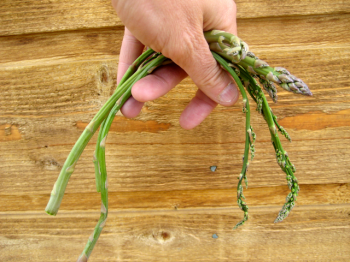
He studied the dry remains of a prior year’s plant, noticing that “the old asparagus plant stood about three feet high and had a central stem or ‘trunk’ about a half inch in diameter which easily distinguished it from weeds with forking stems,” before comparing it to “a slender Christmas tree.”
“After getting the size, color and form thoroughly in my mind, I stood up and looked back along the ditch bank,” he wrote. “Instantly, I saw a dozen old dead asparagus stalks that I had missed.” He then quickly filled up his pail with fat spears.
A week later the young Gibbons noticed that “all the asparagus that had not been kept closely cut was waving its fernlike foliage in the breeze, but where I had taken each spear as soon as it had appeared, the perennial roots kept sending up more new shoots to replace those I had stolen.” Get cutting and keep coming back to the same spot—that’s the message I pulled from that.
“I doubt that young people today can realize how good the first green vegetables of spring tasted in those days before quick freezing and fast transportation began furnishing us with fresh vegetables all winter,” Gibbons concluded in the grandfatherly voice I have come to know and love.
That day, Wendy and I came home with a small batch of asparagus. Our meager collection consisted of stalks that were either too skinny, too old, growing out of dried dog poop, or curled back towards the ground as if man or beast had repeatedly sprayed them. But it was wild asparagus nonetheless. I washed the batch vigorously, soaked it in a vinegar/water solution, and after much consideration prepared it the same way I always prepare the store-bought kind.
Sweet Soy-Glazed Asparagus
- Simmer asparagus spears in a deep frying pan in an inch of water for 10-15 minutes until almost all of the water is gone and you can get a fork through the spears.
- Drizzle soy sauce on top, enough so that some collects under the asparagus and bubbles around it.
- Sprinkle a coat of organic cane sugar on top.
- Turn heat to low and let cook another 5 minutes or so until the soy sauce caramelizes and the asparagrass looks slightly glazed.
- Serve with something worthy, like a nice steak, fish, or tempeh steaks.
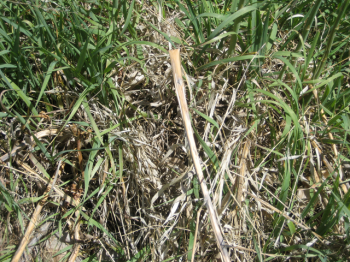
A Where’s Waldo of wild asparagus. In the upper right corner you can see two mature stalks stretching out of the photo.
Second Finding
On Mother’s Day, Gregg’s mom led us on a brief asparagus hunt on the outskirts of Denver even though she’d never hunted asparagus before and it was her special day and not mine. As we detoured onto a narrow footpath to get closer to the creek, I announced that there would be a prize for the first person to find wild asparagus.
Nancy and I delved deep into the most overgrown spaces, but it was while standing along the footpath, chatting with Jim and waiting for Nancy and me, that Gregg looked down and saw it. “Is that asparagus?” he asked Jim. It was.
Gregg came tromping through the forest all nonchalant-like holding a spear the length of his arm: “Is this what you’re looking for?”
“Eureka! Gadzooks! You found it!!” I cried with all manner of foot stomping and incredulity before going back to examine the unobtrusive pile of prior-year’s stalks. We had to search for the “Christmas tree” in the trodden heap of dry grey-white remains, as it was no longer upright. From the base a handful more fat spears protruded, including one all-white one growing in the shade of some grasses. We collected these and headed back to the car, Jim incredulous that asparagus actually grows wild, me giddy with glee over found asparagus despite the fact that once again, I did not actually find it myself. Gregg’s prize was my good humor.
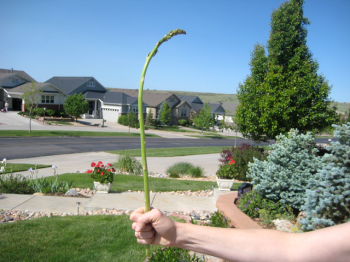
I spent the next day obsessively stalking asparagus. I crept out of his parents’ house early to traverse the open space in the middle of their housing development, but alas, next to nothing grows there. Jim tells tales of clandestine weed sprayers hitting plants in the dead of night. On top of that, a golf course wends its way through.
We returned to the asparagus spot later that day. I wildcrafted nettles and orache maniacally while Gregg stood patiently by. We didn’t find any more asparagus—in fact I walked right by the spot from the day before—but I did see a young skunk plodding to the top of a knoll that I was about to scale looking for fat spears. How thankful I am not be sprayed by a skunk!
Wild Wins Again
A few days later up in the mountains I prepared the Mother’s Day batch in the same style of Sweet Soy-Glazed Asparagus.
I eat a lot of wild vegetables, but it is another thing to eat a wild vegetable that one is accustomed to eating from the store. Unlike with “weird” wild vegetables, the comparison does not require abstraction. It is apples to apples, so to speak—except that really it’s not. Let me put it this way: If you make this recipe with store-bought asparagus, it is sure to be good, but if you make it with wild asparagus, it will knock your socks off.
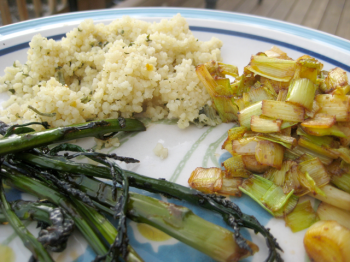
Gregg and I liked it so much that we split the tough lower-stalk pieces lengthwise with a knife and sucked out the tender goodness within.
A Happy Ending
“My neighbors often smile when they see me by the roadside with my asparagus knife and pail,” Euell Gibbons wrote. “They think it is much simpler to merely buy the asparagus one wants at the supermarket. But I have a secret they don’t know about. When I am out along the hedgerows and waysides gathering wild asparagus, I am twelve years old again, and all the world is new and wonderful as the spring sun quickens the green things into life after a winter’s dormancy. Now do you know why I like wild asparagus?”
UPDATED 4.28.20: Minor changes

Holy frickin’ cow E, I think this is my favorite thing that you ever wrote. Magical! You’ve captured the joy of it.
Oh? Thanks! Though I think ol’ Euell probably deserves half the credit;)
Holy Cow! I know that plant in the second picture!
I’m very pleased about getting a “holy cow” from Rico:)
An amusing account. I didn’t know there was a legend concerning asparagus. Anyway, the recipe is interesting to try . My thanks for sharing that.
A fantastic piece, thanks. I was recently in an urban reserve for work and discovered my first wild asparagus – and doesn’t being a Euell Gibbons’ fan make it special! ‘Stumbling on the wild asparagus’ in my blog post. A similarly modest harvest, but it only wants a few precious serves to keep its specialness. Thanks again. Oliver
This is great! Thank you.
Awesome…and even in Colorado! Sweet!
…I’m going to find some this year…yum!
I know of two cities near denver that I’ve personally found Asparagus ; ) Happy hunting!
Would love to have this one! But I live pretty high up in the Colorado mountains.
Am I likely to find wild asparagus over 8,000 ft.?
Also have noticed “ greens” growing in a small run-off creek and wondered if any of it is edible? The cows seem to like it.
Thsnks,
Connie Qualey
Hi Connie, there are probably edible greens in your creek, but we need more information. Maybe you can share a photo, or describe them carefully.
Oh and I meant to say that I have definitely found wild asparagus at 8,000 feet, but not much higher. It is more common in lowland valleys by ranches, farms, irrigation ditches, and fence lines.